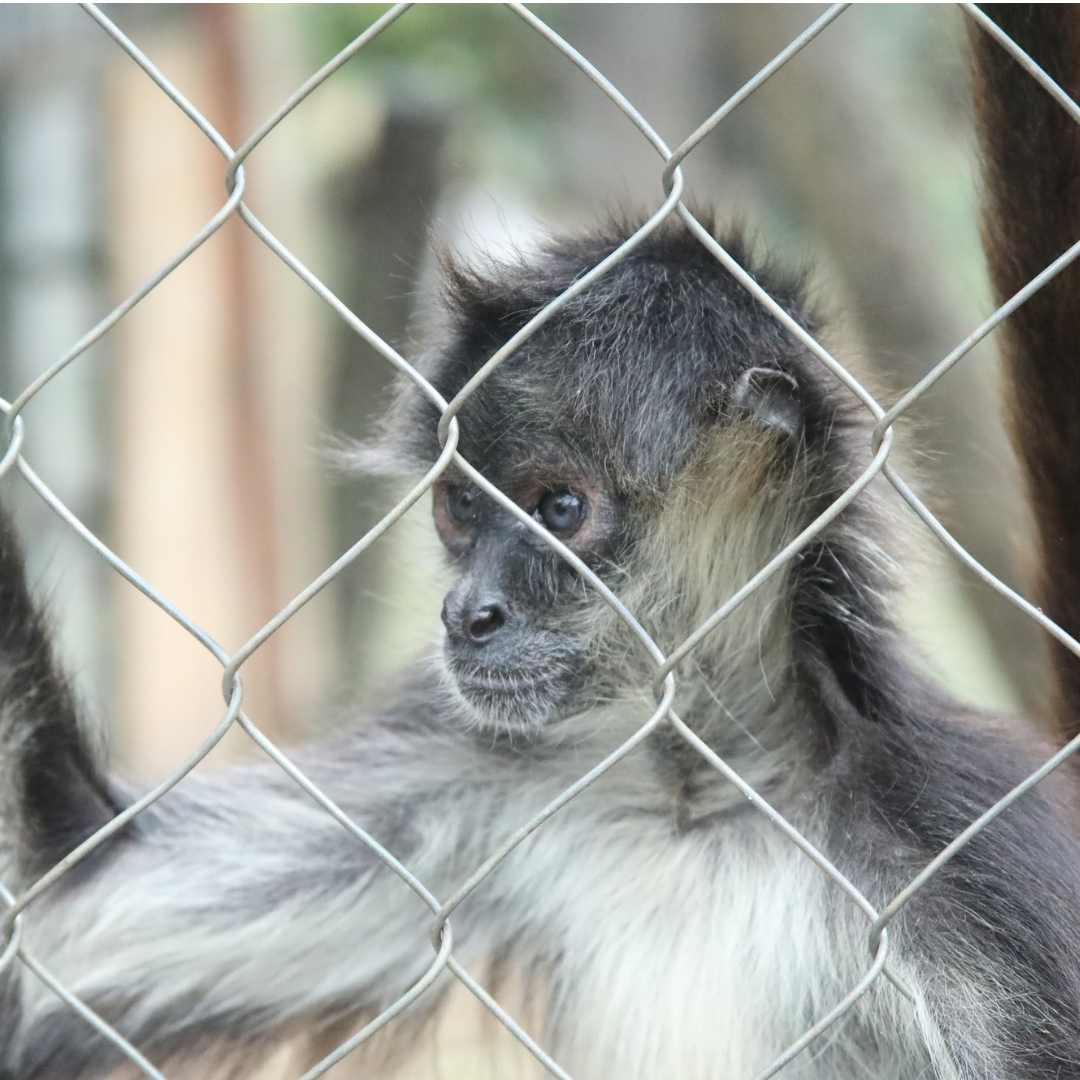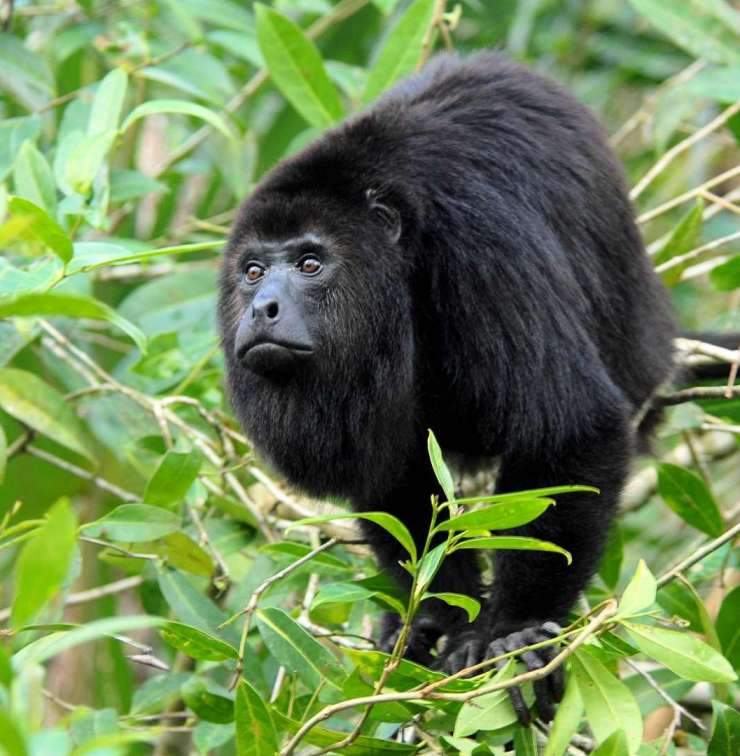Diet and behavior
This animal’s diet consists mostly of fruits, plus leaves, nuts, seeds, and sometimes arachnids and insects. Spider monkeys are important seed dispersers for their rainforest homes. When animals eat fruit and nuts from trees and then go on their merry way, they eventually defecate the seeds and spread the tree species throughout the area. Between 50 and 90 percent of seed dispersal in tropical forests is done by animals.
Spider monkeys are social, living in groups of up to 40 members. Within that group, smaller subgroups will often splinter off to forage. A 2014 study of Mexican spider monkeys in Belize found that males and females spent their time differently, with females doing more eating and resting and males eating more ripe fruits and traveling. Males are likely on the move because they’re patrolling their borders and raiding other troops before returning to check on the females.
Reproduction
Spider monkey males and females are both known to have multiple sexual partners, but their reproductive behaviors are difficult to document, even in captivity, and weren’t even observed until the 1970s.
But there have been some discoveries: A 2010 study on the black-faced spider monkey found that males must scramble to find and mate with the few receptive females in a single mating period. It also noted that most trysts took place in secret. Like other primates, spider monkeys form consortships in which males and females pair up and leave the group for periods as short as a few days. Spider monkeys have a long gestation period, from seven to 7.5 months. They don’t have a single breeding season, but an individual spider monkey will wait about two to four years before giving birth again. Infants are born with full body hair except for the bare skin around the eyes of their “baby face.” Mostly helpless, newborns cling to their mother, who provides parental care, and don’t wean for as long as two years.
According to the International Union for Conservation of Nature, all spider monkey populations are decreasing. The most stable wild population—that of the Guiana spider monkey of Guyana, French Guyana, Surinam, and Brazil—is still vulnerable to extinction. Human activities including farming, ranching, and road construction are destroying the monkey’s habitat—even though much of its home range is protected.
The least stable population is the brown spider monkey, found in Colombia and Venezuela. These animals are critically endangered, a distinction that places them just two steps away from extinction. They are a favorite target of hunters, who shoot them for sport and to make medicine to treat a variety of maladies from rheumatism to snake bites.
Their forest homes are also being cleared for cattle ranching, agriculture, logging, and human settlements. Pockets of forest that are left may no longer be sustainable and only 20 percent of the species’ historical distribution remains. Some protections have been put in place for this species, including local awareness programs in Venezuela and ongoing surveys to find the species and forests that could potentially be protected in Colombia.
Physical Description
Tigers have reddish-orange coats with prominent black stripes, white bellies and
white spots on their ears. Like a human fingerprint, no two tigers have the exact
same markings. Because of this, researchers can use stripe patterns to identify
different individuals when studying tigers in the wild. Tigers are powerful hunters
with sharp teeth, strong jaws and agile bodies. They are the largest terrestrial
mammal whose diet consists entirely of meat. The tiger’s closest relative is the lion.
In fact, without fur, it is difficult to distinguish a tiger from a lion.
Size
Tigers are the largest cat species in the world, and the Amur tiger is the largest
subspecies with males weighing up to 660 pounds (300 kilograms) and measuring 10
feet (3 meters). Sumatran tigers are the smallest subspecies, maxing out at 310
pounds (140 kilograms) and 8 feet (2.4 meters). Female tigers of all subspecies tend
to be smaller than their male counterparts.
Native Habitat
Historically, tigers existed throughout much of Eastern and Southern Asia, as well as
in parts of Central and Western Asia and the Middle East, surrounding the Caspian
Sea. Their range has diminished significantly as human populations have expanded.
Itis believed they currently occupy just 7 percent of their historic range.
Presently, tigers are found in a variety of habitats across South and Southeast Asia,
China and Eastern Russia. They thrive in temperate, tropical or evergreen forests,
mangrove swamps and grasslands. Amur tigers are primarily found in Far-East
Russia, although there are small populations across the border into China and
potentially North Korea. Sumatran tigers are found only on the Indonesian island of
Sumatra. A tiger’s range within these regions is determined by the availability of
prey.
Communication
Despite their solitary nature, communication is a very important part of tigers’
behavioral ecology. They communicate through vocalizations, such as roaring,
grunting and chuffing, and through signals, such as scent marking and scratches on
trees. Tigers are fiercely territorial animals, so these signals are particularly
important to communicating where one tiger’s home range ends and another’s
begins.
Food/Eating Habits
Tigers are solitary ambush predators that rely on stealth and strength to take down
prey. These apex predators primarily hunt large ungulates, such as wild boar and
deer, but are also known to consume monkeys, buffalo, sloth bears, leopards and
even crocodiles. When tigers are found in close proximity to humans, they may also
feed on domestic animals, such as cattle or goats. Tigers are adept swimmers and
have even been recorded hunting in the wild.
These powerful cats hunt primarily at night, using sight and sound to identify prey.
Their striped coats help them blend into their surroundings, where they lie in wait for
prey to pass by. At the opportune moment, tigers pounce on their prey, take it to the
ground and finish the kill by breaking or biting the neck. Tigers hunt about once a
week and consume as much as 75 pounds (34 kilograms) of food in one night.
At the Zoo, tigers eat ground beef, and their diet is supplemented with enrichment
items each week. They receive knucklebones or cow femurs twice a week and rabbits
once a week to exercise their jaws and keep their teeth healthy.
Social Structure
Tigers are solitary creatures, except when mating or raising young. Cubs stay with
their mothers until they learn to hunt successfully, usually at about 18 to 24 months
old. They reach full independence after two to three years, at which point they
disperse to find their own territory. Female tigers often remain near their mother’s’
territory, while males disperse farther from home.
Reproduction and Development
Female tigers reach sexual maturity between age 3 and 4. Males are sexually mature
at about 4 or 5 years old. Mating can occur at any time of year but most often takes
place during cooler months between November and April. Tigers are induced
ovulators, which means females will not release eggs until mating occurs. Gestation
lasts approximately 100 days, and females give birth to between one and seven
offspring at a time, averaging between two and four cubs. Once cubs become
independent, at about age 2, females are ready to give birth again. However, if a
female’s offspring do not survive, due to causes such as infanticide or starvation, she
is able to conceive another litter right away.
Lifespan
The life span of tigers in the wild is usually between 10 and 15 years. In human care,
or on rare occasions in the wild, a tiger can live up to 20 years. However,
approximately half of all wild tiger cubs do not survive past the first two years of life.
Only 40 percent of those that reach independence actually live to establish a territory
and produce young. The risk of mortality remains high for adult tigers due to their
territorial nature, which often results in direct competition with conspecifics, or
members of the same species.













